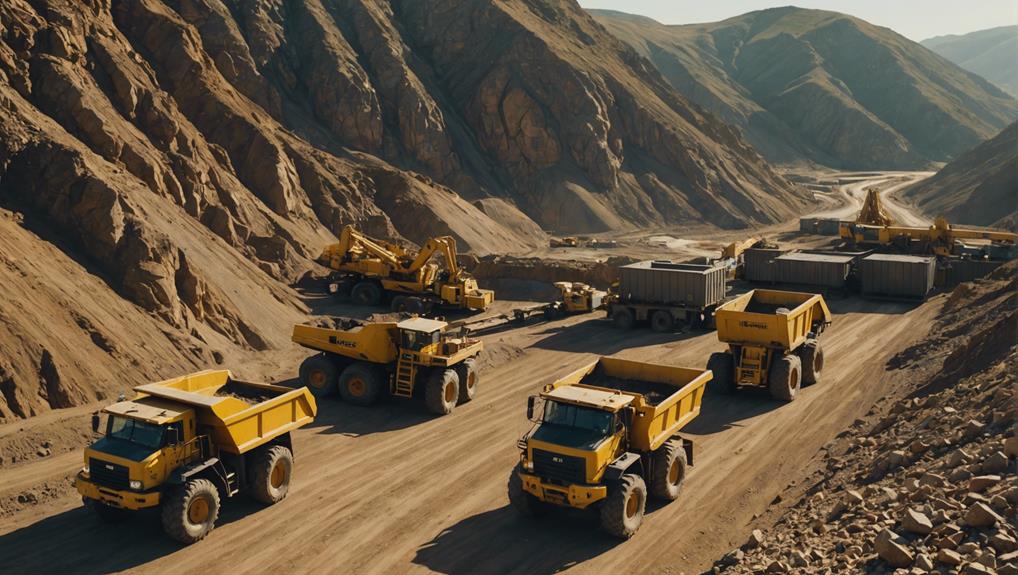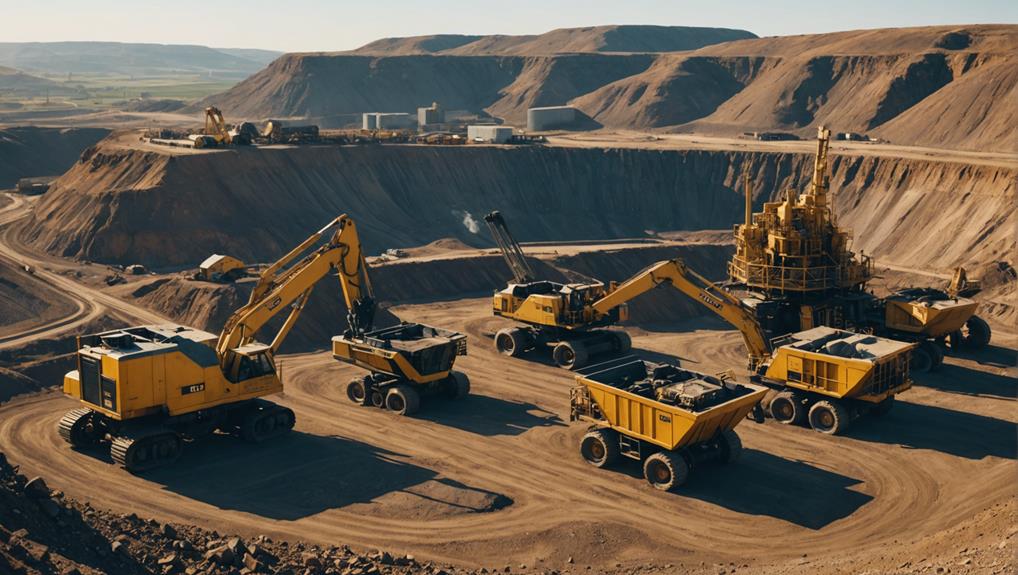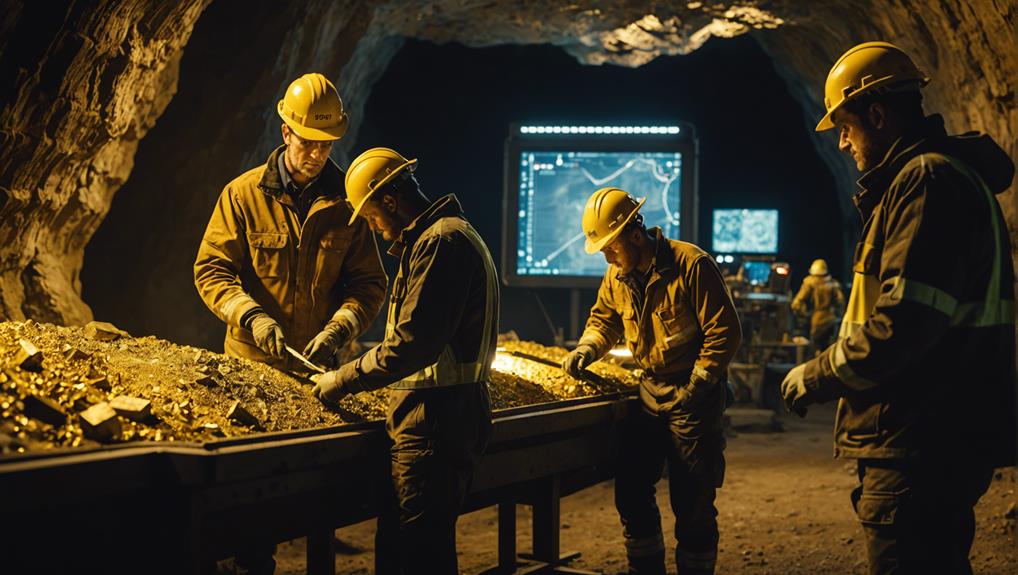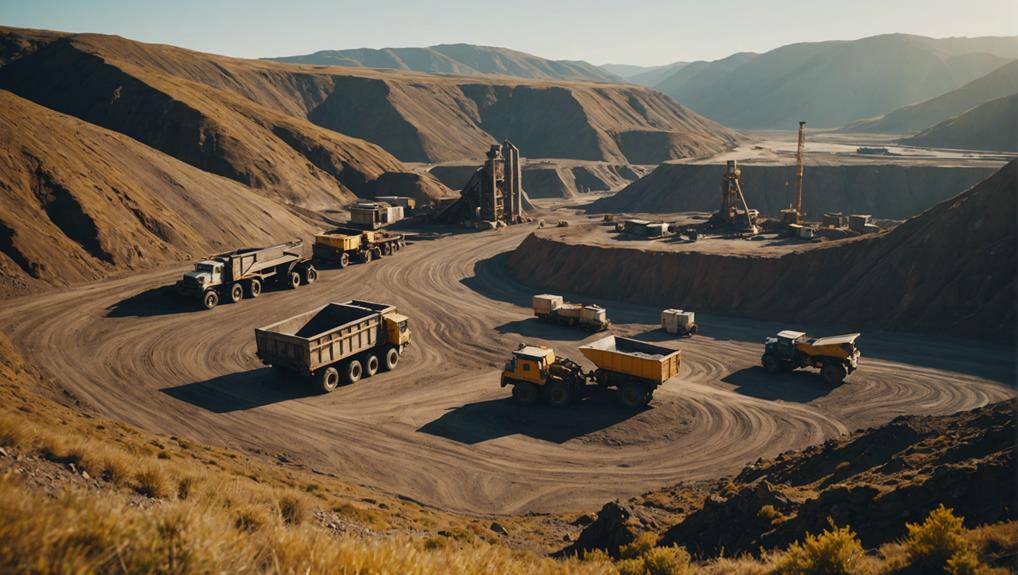In the gold mining industry, you'll encounter three primary types of companies: junior, mid-tier, and major miners. Junior miners, often smaller and more agile, focus on exploration and developing new deposits but face higher risks and volatility. Mid-tier miners, targeting growth, balance exploration with expanding production capabilities and often manage multiple mines to mitigate risk. Major miners dominate the market with extensive resources, benefiting from economies of scale and lower operational costs, which help them maintain stability even in low gold price scenarios. Each type plays an essential role in the industry, offering different risks and opportunities. Exploring further provides deeper insights into each category's strategic approaches and market influences.
Overview of Junior Miners

Junior miners, often seen as the backbone of the industry, play a pivotal role in investigating and developing new gold deposits. You'll find these companies at the forefront of the hunt for new resources, typically in regions less touched by major players. They're smaller, more agile, and can pivot quickly, which allows them to survey geological territories that are often overlooked.
This focus on investigation rather than production allows them to potentially uncover significant gold deposits, which can lead to substantial rewards if they're successful in their ventures. They're important in maintaining a steady pipeline of new mining projects, ensuring the industry's sustainability.
As they progress, these junior miners often become attractive targets for acquisition by larger mining companies looking to expand their reserves.
Risks of Junior Mining

Despite their potential for high rewards, investing in junior miners carries significant risks due to their exposure to volatile market conditions and limited financial resources. You're often dealing with companies that lack the established operations of larger firms, which can lead to greater unpredictability in their stock prices. Another major concern is their dependence on investor sentiment and financing, which can dry up quickly if market conditions sour or results from exploration are underwhelming.
Moreover, juniors usually have a single project or are focused in one geographic area, increasing the risk if that project fails or local political issues arise. You must additionally consider the potential for mismanagement or lack of experience in maneuvering through complex regulatory environments, which can stall or entirely derail projects.
Growth Strategy of Mid-Tier Miners

Exploring growth strategies, mid-tier miners often expand through strategic acquisitions and the development of existing assets. You'll find that these companies focus on enhancing their production capabilities and reserve bases to capitalize on economies of scale. They're not simply acquiring any assets; they typically target under-valued or under-explored properties that promise quick turnover and high returns.
Moreover, mid-tier miners maximize the potential of their current projects by investing in advanced technologies and efficient mining techniques. This not only increases their output but also extends the life of their mines. They're particularly adept at optimizing operational efficiencies, which helps them scale up production without proportionate increases in costs. This strategic blend of expansion and optimization fuels their growth and positions them for future success.
Financial Health of Mid-Tier

How stable are the financial foundations of mid-tier gold mining companies? Typically, they're more established than junior miners but don't have the vast resources major players boast. You'll find that these companies often strike a balance between investment in exploration and maintaining profitability. Here's what sets them apart:
- Critical Revenue Streams: They usually operate multiple mines, which helps to mitigate the risk if one project underperforms.
- Robust Financial Practices: Mid-tier miners generally have access to better financing options and exhibit disciplined spending.
- Adaptive Strategies: They're nimble enough to adjust operations based on market conditions, which can lead to more stable financial outcomes compared to smaller miners.
This equilibrium helps them maintain a solid financial health, crucial for sustaining operations and funding future growth.
Major Miners Market Dominance

Major gold mining companies dominate the market, leveraging their extensive resources and global reach to outperform smaller competitors. You'll find these giants effectively manage vast portfolios of mines across multiple countries. They benefit significantly from economies of scale, reducing operational costs and securing bulk processing rates that smaller miners can't access.
This financial advantage allows them to maintain stability even during periods of low gold prices, a challenge often too great for their junior counterparts. Moreover, their substantial market capitalization and robust revenue streams enable aggressive acquisition strategies, further consolidating their market position. As an investor or industry observer, you'd notice these majors exert significant influence on global gold prices and mining trends, shaping the sector's landscape.
Innovation in Major Mining

You'll find that major gold mining companies aren't simply sticking to old methods; they're at the forefront of pioneering advanced extraction technologies.
They've furthermore committed to sustainable mining practices, ensuring that their operations are environmentally sound.
Additionally, the integration of automation and robotics is streamlining processes, making mining safer and more efficient.
Advanced Extraction Technologies
Leading gold mining companies are quickly embracing advanced extraction technologies to improve efficiency and reduce environmental impact. As you're evaluating the landscape of major mining firms, it's essential to recognize the technological strides being made. These innovations not only streamline operations but are vital in maintaining competitiveness in the global market.
Here are some important technologies being adopted:
- Automated drilling systems improve precision and drastically cut down on operation time.
- Real-time data analytics allow for immediate adjustments to mining processes, optimizing yield.
- Sensor-based ore sorting technology enhances the efficiency of material handling and significantly reduces energy consumption in the beneficiation process.
Understanding these advancements can help you gauge a company's potential for growth and sustainability in the industry.
Sustainable Mining Practices
Building on the technological advancements, many gold mining companies are now prioritizing sustainable mining practices to further reduce their environmental footprint. You'll find that these efforts often revolve around innovative waste management strategies and water conservation technologies. These companies aim to not only comply with regulations but to set a benchmark in environmental stewardship.
| Sustainability Focus | Impact |
|---|---|
| Water Reuse Systems | Reduces freshwater intake |
| Tailings Reprocessing | Minimizes waste generation |
| Renewable Energy Sources | Lowers carbon emissions |
| Biodiversity Programs | Enhances local ecosystems |
| Community Engagements | Improves social acceptance |
These initiatives reflect a shift towards more responsible mining practices, ensuring that the industry can continue to thrive while minimizing its ecological impact.
Automation and Robotics
Many major gold mining companies are now incorporating automation and robotics to improve efficiency and safety in their operations. You'll find that these technologies not only cut down on operational costs but also minimize human exposure to dangerous mining conditions.
- Autonomous Vehicles: These machines operate without a human driver, which significantly reduces accidents related to human error.
- Drone Technology: Drones are used for aerial surveys, allowing for precise mapping of mining sites without putting survey crews at risk.
- Robotic Process Automation (RPA): RPA systems handle repetitive tasks, from data entry to ore sampling, enhancing productivity and reducing the potential for errors.
These innovations are reshaping how major mining companies approach the challenges of modern gold extraction.
Comparative Analysis of Profitability

When comparing gold mining companies, it's important to consider how profit margins vary and the impact of operational costs on profitability.
You'll find that some companies achieve higher margins due to efficient cost management and advanced technology.
Understanding these factors can help you identify the most financially sound investments in the gold mining sector.
Profit Margins Variation
Profit margins among gold mining companies vary significantly, reflecting differences in operational efficiency and market conditions. As you explore this sector, you'll notice that profitability isn't uniform across the board. Here's a brief rundown:
- Major Companies: Typically enjoy higher profit margins due to economies of scale and more diversified operations.
- Mid-Tier Companies: Experience moderate profit margins, often balancing growth and operational stability.
- Junior Companies: Generally have lower profit margins, impacted by their focus on exploration and development rather than production.
Understanding these variations can help you gauge the financial health and investment potential of companies within the gold mining industry, offering valuable insights into where each type stands in the competitive landscape.
Operational Cost Impact
Understanding the variations in profit margins, let's now examine how operational costs impact the profitability of gold mining companies. You'll find that junior miners often face higher operational costs relative to their size, as they're developing their mining projects. This can eat into their margins significantly.
On the other hand, mid-tier and major miners benefit from economies of scale. They've got larger, established mines and can spread costs over more output, which generally lowers their cost per ounce of gold produced.
This difference means that while junior miners might struggle to remain profitable during periods of low gold prices, major companies can still manage to turn a profit. It's important for you to consider these cost structures when investing.
Future Trends in Gold Mining

While technological advancements continue to reshape the landscape, you'll find that sustainability and efficiency are becoming pivotal trends in the future of gold mining. As you explore through the evolving sector, consider these significant developments:
- Automation and Robotics: These technologies are streamlining operations, reducing the need for human intervention and enhancing safety.
- Renewable Energy Integration: More mines are transitioning to solar, wind, and hydroelectric power sources to cut emissions and lower energy costs.
- Advanced Material Processing: Innovations in metallurgy and chemical processing are improving gold recovery rates and reducing environmental impact.
These trends won't only help you understand where the industry is headed but also direct your investment and operational decisions in this dynamic field.
Conclusion
In the world of gold mining, each type of company serves a unique purpose. Junior miners, though they're high-risk, offer the potential for significant rewards, making them intriguing for those who prefer more control over their investments and are wary of traditional banking systems, which often seem to cater only to the wealthy. Mid-tier miners present a more balanced approach, providing a blend of growth and stability that can shield investors from the wild swings of less established ventures. Major miners, on the other hand, are the behemoths of the industry, driving innovation and maintaining profitability with a steadiness that can appeal to those disillusioned with the unpredictability and self-serving nature of politicians and monetary systems.
This deep-seated distrust in banks, coupled with a desire for more direct oversight of one's financial affairs, underscores the appeal of investing in gold. Gold represents a tangible asset, far removed from the abstract machinations of modern financial systems and political maneuvering. It's an investment that offers a sense of security and autonomy, allowing individuals to step away from the systemic inequities favored by the affluent elite.
In light of these insights, it's crucial for anyone interested in safeguarding their financial future to consider the unique opportunities presented by gold mining investments. Aligning your investment with your risk tolerance and the desire for more substantial control over your financial destiny is essential in this volatile sector. To navigate these waters with more confidence, we encourage you to request your free gold information kit today. This kit will arm you with the knowledge needed to make informed decisions that resonate with your personal investment philosophy.
The Gold Information Network
11900 Biscayne Blvd, Ste 127B, Miami, FL 33181
(305) 449-9094
https://goldinfo.net







